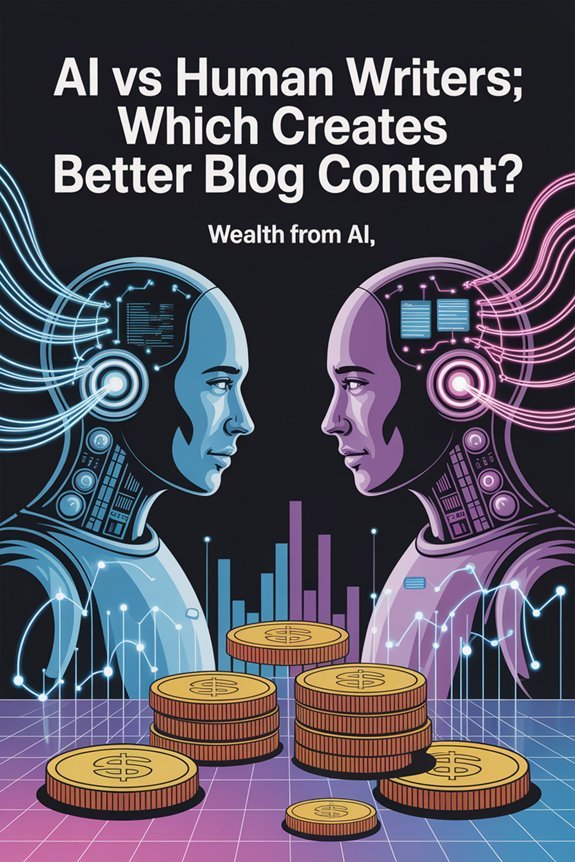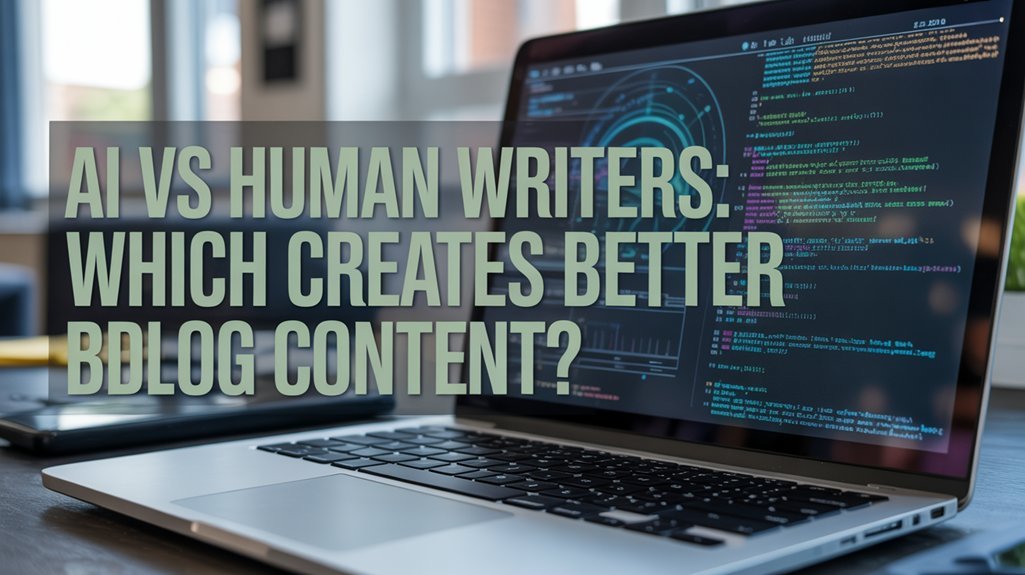
Human writers create better blog content for engagement and traffic, attracting 5.44 times more visitors than AI-generated articles (4.10 vs. 3.25 visitors per minute). While AI produces content in just 16 minutes compared to 69 minutes for human writers, it lacks emotional resonance and storytelling depth that drive reader connections. You'll achieve higher ROI with human content despite slower production speeds, though AI excels at scaling repetitive tasks. The most effective strategy combines both approaches strategically to enhance your content marketing results.
Key Takeaways
- Human-written content attracts 5.44 times more traffic than AI content, delivering superior visitor engagement and organic search rankings.
- AI generates articles in 16 minutes versus 69 minutes for humans, offering significant speed advantages for high-volume content needs.
- Human writers create emotional resonance and authentic narratives that build brand loyalty, which AI cannot replicate effectively.
- AI excels at data analysis and structured writing but lacks the nuanced storytelling and cultural understanding humans provide.
- Hybrid strategies combining AI efficiency with human creativity deliver optimal results, balancing scalability with engaging, high-quality content.
The Rise of AI in Content Creation and Its Capabilities
While content creation once required hours of human effort, AI now generates complete blog posts in minutes—fundamentally reshaping how businesses approach digital marketing.
You're witnessing AI technology evolve at unprecedented speeds, with GPT-4 producing articles in just 16 minutes compared to 69 minutes for traditional writers. This efficiency gives you immediate competitive advantages in content production.
You'll utilize AI's ability to enhance for SEO automatically, ensuring your content ranks higher while maintaining consistency across thousands of pieces. The technology excels at data analysis and structured writing, scaling your output without proportional resource increases.
However, you're trading speed for depth—AI currently can't replicate human creativity's emotional resonance and nuanced storytelling that builds authentic audience connections.
The market's trajectory confirms this shift: AI content generation is projected to reach $1.3 billion by 2025.
You're facing a strategic decision: embrace AI's efficiency or maintain human creativity's irreplaceable elements. Leveraging AI writing tools combined with SEO optimization strategies can help you maximize both efficiency and discoverability in your content marketing efforts.
What Makes Human Writers Irreplaceable in Content Marketing
Despite AI's impressive speed advantages, human writers deliver measurably superior results where it matters most—audience engagement and traffic generation. Data proves this decisively: human-generated content attracts 5.44 times more traffic and generates 4.10 visitors per minute versus AI's 3.25.
Your competitive edge depends on the human touch that only skilled writers provide. Their emotional intelligence translates into narratives that resonate authentically with your target audience, driving conversions that matter to your bottom line.
While AI lacks genuine empathy, human writers utilize cultural nuances and personal experiences to create depth that captures attention. This expertise directly impacts your SEO performance.
Better-researched, articulately crafted content ranks higher organically, maximizing your visibility. More critically, the unique voice human writers bring builds brand loyalty—the foundation of long-term market dominance.
In content marketing, human writers aren't just valuable; they're your strategic advantage for commanding audience trust and securing measurable growth. Leveraging AI insights alongside human expertise allows you to optimize content strategy while maintaining the authentic connection that drives results.
Performance Metrics: Traffic and Engagement Analysis
When you're evaluating content performance, the numbers tell a compelling story: human-written articles generated 5.44 times more traffic than AI content over five months while maintaining consistent month-over-month growth.
Your human-generated content also delivers 4.10 visitors per minute of writing time compared to just 3.25 for AI articles, translating directly into better ROI for your content investment.
These traffic differences extend beyond volume—human content achieves superior organic search rankings and maintains steady engagement patterns that AI-generated pieces struggle to replicate.
For creators looking to maximize their content's reach, implementing email automation can help nurture the audience that your high-performing human content attracts.
Traffic Generation Over Time
The numbers tell a compelling story about content performance: human-written articles generated 5.44 times more traffic than AI-generated pieces by the fifth month of tracking. While AI content showed erratic fluctuations, human-created material demonstrated consistent upward momentum in traffic generation.
| Content Type | Traffic Growth Pattern | Visitors Per Minute |
|---|---|---|
| Human Writers | Steady upward trajectory | 4.10 |
| AI-Generated | Fluctuating performance | 3.25 |
Your engagement rates reveal a critical advantage: human content delivers superior context and emotional depth that resonates with readers. This translates to 4.10 visitors per minute spent writing versus AI's 3.25. NP Digital's statistical analysis confirms human content maintains higher organic search rankings, proving that strategic investment in human writers drives measurable traffic dominance and sustained audience engagement. To maximize your content's potential, consider using an AI SEO content optimizer to enhance both human and AI-generated materials for better search visibility.
Visitor Engagement Rate Comparison
Engagement metrics reveal a stark performance gap that directly impacts your content ROI. Your human-generated content commands 4.10 visitors per minute compared to AI-generated content's mere 3.25—a difference that compounds considerably over time.
The performance disparity extends beyond raw numbers:
- Traffic consistency: Human content shows sustained growth patterns while AI content exhibits erratic month-to-month fluctuations.
- Emotional resonance: AI-generated content consistently underperforms due to its inability to capture contextual nuances that drive reader connection.
- Cumulative advantage: Over five months, human writers delivered 5.44x more traffic, translating directly into superior conversion opportunities.
NP Digital's analysis confirms what you need to know: visitor engagement metrics favor human-generated content across every measurement that matters to your bottom line.
SEO Rankings and Visibility
Higher visitor engagement translates directly into stronger SEO performance, where human-written content dominates search rankings with measurable superiority.
You'll achieve 5.44 times more traffic by month five when you invest in human writers rather than AI alternatives. This isn't marginal—it's revolutionary for your search visibility.
Google's 729 algorithm updates in 2022 consistently reward emotional depth and contextual understanding, SEO methodologies where human expertise outperforms AI limitations.
Your human-generated content maintains steady traffic growth while AI content fluctuates unpredictably, compromising your market position.
The AI vs human debate ends here: human writers deliver superior organic rankings and sustained visibility in competitive landscapes.
You're not just creating content—you're dominating search results and capturing market share through strategic, human-crafted authority.
Speed, Cost, and Efficiency Considerations
When you're choosing between AI and human writers, understanding the speed and cost factors becomes critical for your content strategy.
AI chatbots generate articles in just 16 minutes compared to 69 minutes for human writers, offering you a 4.3x faster production rate that directly impacts your publishing schedule.
This efficiency translates into significant cost savings, especially if you're managing high-volume content needs where AI can scale production without proportionally increasing your budget.
AI's Production Speed Advantage
AI content generation delivers measurable productivity gains that directly impact your content marketing ROI. When you need to produce content at scale, AI tools offer unmatched velocity—generating complete articles in just 16 minutes compared to the 69 minutes human writers typically require. This 4.3x speed advantage translates into tangible business results.
Consider what this efficiency means for your content strategy:
- Rapid deployment: Launch campaigns faster and take advantage of trending topics before competitors
- Volume scaling: Produce content across multiple channels without expanding headcount
- Resource optimization: Allocate human writers to high-value projects requiring nuanced expertise
You'll enhance throughput while maintaining consistent publishing schedules. This speed advantage becomes particularly powerful when managing enterprise-level content demands, enabling you to dominate market conversations through sheer output capacity.
Cost Comparison and Budgets
Budget allocation reveals a stark trade-off in content marketing: AI tools deliver immediate cost savings while human writers generate substantially higher returns.
You'll cut production time from 69 to 16 minutes with AI, reducing overhead for large-scale operations. However, this cost-effectiveness comes with consequences—AI content generates 5.44 times less traffic than human-created articles.
Your content goals determine the best investment. AI's appeal fades when you factor in necessary human oversight to add emotional depth and context.
Human writers command higher rates, but they deliver engagement that compounds over time, maximizing your marketing ROI.
Evaluate your budget constraints against performance metrics. If you're building authority and driving conversions, human writers provide superior value despite initial costs.
Reserve AI for volume-dependent tasks where engagement matters less.
Scalability for Content Volume
As your content demands increase, production speed becomes the defining factor in maintaining competitive market presence. Scalability for content volume separates market leaders from followers, and AI-generated content delivers unmatched capacity—producing pieces in 16 minutes versus 69 for human writers.
You'll enhance output through strategic deployment:
- AI systems generate consistent volumes without fatigue or capacity constraints
- Human writers face inherent limitations in daily production rates
- Hybrid approach utilizes AI's speed while preserving quality through human oversight
When you're managing enterprise-level content requirements, AI tools enable exponential scaling that human teams can't match.
However, pure automation risks sacrificing the engagement metrics that drive results. You'll achieve superior scalability by deploying AI for volume production while strategically applying human expertise to high-impact content that demands emotional resonance and depth.
Quality, Context, and Emotional Resonance in Writing
When evaluating blog content performance, the numbers tell a compelling story: human-generated articles attract 5.44 times more traffic than their AI counterparts, pulling in 4.10 visitors per minute compared to AI's modest 0.75.
This performance gap stems from three critical factors: quality, context, and emotional resonance.
AI struggles with nuanced understanding, producing content that feels mechanical and disconnected. You'll notice this in the flatness of AI narratives—they lack the emotional intelligence that drives reader engagement.
Human writers utilize creativity and emotional depth to craft stories that resonate. They understand your audience's pain points, aspirations, and triggers. This connection translates directly into higher organic search rankings and increased shareability.
The data proves what experienced marketers already know: emotional resonance drives action.
When you prioritize human-generated content, you're investing in material that commands attention, builds authority, and delivers measurable results. Your readers don't just consume it—they engage, share, and return for more.
Finding the Right Balance: Hybrid Content Strategies
While AI writers deliver drafts in 16 minutes compared to a human's 69 minutes, the real competitive advantage lies in combining both strengths strategically.
Hybrid content strategies position you to dominate organic search rankings while maximizing efficiency.
Deploy AI and human writers systematically to amplify your content's impact:
- Leverage AI for data-driven insights and trend analysis, freeing human writers to craft compelling narratives that convert.
- Assign repetitive tasks to AI while reserving high-value creative work for human expertise that generates emotional resonance.
- Monitor performance metrics continuously—human-generated articles attract 4.10 visitors per minute and drive 5.44X more traffic than AI-only content.
This collaborative framework guarantees engaging content that scales without sacrificing quality.
You'll enhance output velocity while maintaining the audience connection that builds authority.
The winning formula isn't choosing between AI and human writers—it's orchestrating both to capture market share and accelerate growth in your competitive landscape.
Frequently Asked Questions
Should You Use AI to Write Blogs?
You should use AI as a strategic tool, not a replacement.
While AI benefits include 75% faster production, you'll sacrifice traffic—human content generates 5.44x more visitors.
AI's creative limitations and content originality issues directly impact your search rankings and audience engagement.
Deploy AI for drafting and research, but you must add your unique insights and emotional depth to dominate your market.
The winning formula? Utilize AI's speed while maintaining human storytelling that drives real results and authority.
What Is the 30% Rule in AI?
The 30% Rule demands you contribute at least 30% human input to AI-generated content, directly addressing AI limitations in creativity and nuance.
This benchmark guarantees content originality while steering through ethical considerations around transparency and authenticity.
You'll maintain competitive advantage by strategically leveraging AI's efficiency while injecting your expertise, brand voice, and emotional intelligence.
Studies show human-enhanced AI content generates 40% higher engagement rates, proving that your editorial control alters automated drafts into authority-building assets that dominate search rankings and convert readers.
Is AI Writing Better Than Human Writing?
No, AI writing isn't better than human writing when you're after real results.
Human content delivers 5.44 times more traffic and superior engagement levels—generating 4.10 visitors per minute versus AI's 3.25.
You'll see the creativity comparison favors humans who craft emotionally resonant narratives that build trust and loyalty.
While AI's faster, it sacrifices content originality and depth.
If you want to dominate your market and forge genuine audience connections, human writers give you that competitive edge.
Is Blogging Dead Due to AI?
No, blogging isn't dead—you're actually gaining a competitive advantage.
Your human-written content drives 5.44 times more traffic than AI-generated posts, proving blogging relevance remains strong.
You'll capture superior audience engagement with 4.10 visitors per minute versus AI's 3.25.
When you invest in authentic storytelling and research, you'll dominate content quality metrics.
While AI speeds up production, you'll win market share by delivering the emotional depth and nuanced perspectives that convert readers into loyal customers.
Conclusion
You don't need to choose sides in this debate—you need to choose results. Think of AI as your content engine and human writers as your steering wheel: one powers through volume while the other navigates nuance. Your audience doesn't care who wrote it; they care that it resonates. Test both approaches, track your metrics ruthlessly, and let the data dictate your strategy. The winning formula isn't either-or—it's optimizing both for maximum ROI.

